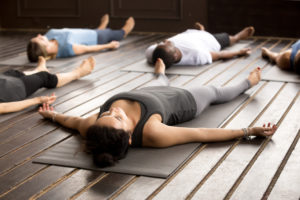
I sat across from my best friend of over 20 years.
Her husband has been in Intensive Care for over a month.
He wasn’t feeling well, checked himself into the ER, and 30 minutes later, was comatose, in septic shock, fighting for his life.

He is only 46 years old. They have two young children, a successful business, and a long road to recovery.
My best friend reeled off to me the endless list of to-do’s with the kids and business, and now her husband requires tremendous care and attention.
She isn’t just overwhelmed with stress and anxiety, she is paralyzed, not knowing where to begin. It’s difficult for her to deal with any single thing, let alone everything.
Maybe you can relate to a time when stress caused you to shut down mentally and physically, impacted your relationships, and kept you wide awake at night.
Why does this happen?
 Stress releases the hormone cortisol into your system which we often experience as the fight or flight response. Psychology Today reports that prolonged stress and too much cortisol causes difficulty with memory, lower immune function, increased weight gain, blood pressure, and cholesterol… not to mention heart disease, decreased resilience, and a trigger for mental illness.
Stress releases the hormone cortisol into your system which we often experience as the fight or flight response. Psychology Today reports that prolonged stress and too much cortisol causes difficulty with memory, lower immune function, increased weight gain, blood pressure, and cholesterol… not to mention heart disease, decreased resilience, and a trigger for mental illness.
What can you do if you are feeling some of these stress and cortisol-related effects?
- Option A is to try and tackle every single thing. It’s daunting, even frightening, and near impossible.
- Option B is to pause, and put everything to the side. Give yourself a chance to release the “fight or flight.”
As I sat across from my stressed out friend, I invited her to take a moment and close her eyes.
I asked her to imagine she was removing this pack of burdens and worries and just setting it down.
Together we took some deep breaths and focused on the next inhale, and the next exhale.
It’s not a hokey-dokey yoga thing.
New research from UC Davis shows that focusing on the present rather than letting the mind drift, may help to lower levels of the stress hormone cortisol.
 Our minds tend to be multi-tasking experts, but that only adds to the stress. Meditation builds the skill of one-pointed focus.
Our minds tend to be multi-tasking experts, but that only adds to the stress. Meditation builds the skill of one-pointed focus.
It’s not easy. When you have a million things on your mind, it requires a kind of mental athleticism to put the pack down and focus on your breath. It’s a skill, a capacity… like learning to serve in tennis or running for longer distances as you train for a marathon.
Even if you take just a minute to push back from your busyness, and shift your attention from all the emails, to-do’s, bills, plans, meetings, calls…
…and just focus on this next inhale…and this next exhale.
Try it…
Zen Buddhist monk Thích Nhất Hạnh said,
“Feelings come and go like clouds in a windy sky. Conscious breathing is my anchor.”

Next time you are really feeling the pressure and stress coming on strong…remember:
“Conscious breathing is my anchor.”
Take a moment to consider the kind of scenario most likely to trigger high levels of stress in your life.
— you are caught in gridlock traffic and you are running late and your headache is splitting!
— your kids are screaming, and you are seconds from going…CRAZY!
— you feel the flu coming on but you have to dig deep and show up for a really important meeting.
In these volatile moments, any little thing can sweep you over the edge.
“Conscious breathing is my anchor.”
Counting your breaths will help you anchor even more deeply.
The 4-7-8 breath is a great example
Let’s try it.
— Exhale through your mouth
— Close your mouth and inhale quietly through your nose as you count to four. (“1…2…3…4”)
— Hold your breath as you count to seven (“1…2…3…4…5…6…7”)
— Exhale completely through your mouth, as you count to eight (“1…2…3…4…5…6…7…8”)
— Now inhale again and repeat the cycle three more times.
Notice how conscious breathing has this way of soothing and…uniting.
I like to think of the breath as the “translator.”
Your mind and body have different agendas. Your mind wants to keep you on schedule, solve all the problems, find creative ideas and solutions.
Your body has its own desires and cravings. It wants movement and touch, yet it has injuries to heal and processes to regulate.
Sometimes the mind and body are out of whack, disconnected, speaking different languages.
As Dr. Andrew Weil says,
“Breathing is the core physiological function. It’s the function that unites mind and body. It gives us access to the master control of the involuntary nervous system. And the fact that it’s never paid attention to is an example of the blindness of our conventional medical system.”
You take over 20,000 breaths in a 24 hour period. Many days go by where we don’t pay attention the sound and feeling of a single breath.
Just one deep breath is a profoundly simple solution to relieving stress…NOW.
Dying…To Relax
 If meditation is not your thing, yoga has a similar effect…especially the most symbolic and most wonderful yoga pose, Savasana.
If meditation is not your thing, yoga has a similar effect…especially the most symbolic and most wonderful yoga pose, Savasana.
“Savasana” means “the corpse pose” or “the death pose.”
In the beginning of this article, I mentioned my friend whose husband has been in Intensive Care for over 30 days, straddling life…and death. Several times, the doctors told my friend that her husband would be passing any minute, and for the family to say their goodbyes.
Imagine the stress (and grief) that caused my friend and her family. Thankfully, her husband survived, against all odds.
Death has that power. It can be downright scary and completely overwhelming. 39% of Americans list the death of a loved one as one of their greatest fears.
I won’t be the first to tell you…death is part of life. Anyone who practices yoga would probably say that Savasana, “the death pose,” is the most wonderful part of yoga.
It teaches us to soften into the mystery, to relax into uncertainty, to breathe into that which scares us, rather than resist it.
Try it. Lie down flat on your back.
Then, put your right hand on your belly and your left hand on your heart.
As you inhale, feel the right hand RISE on your belly.
As you exhale, feel the left hand FALL on your heart.
If you can take 10 minutes for Savasana, it’s powerful. The first few minutes, you might feel the chatter in your mind. But if you stay with it, you’ll feel a shift. Savasana stimulates the parasympathetic nervous system (your rest and digest response) and calms your sympathetic nervous system (your fight, flight and freeze response that pumps all that cortisol into your body).
It’s the simplest advice you’ll ever hear… just lie down and breathe deeply. But it’s so much more than that. Practicing Savasana is your way of saying…let this stressful part of my day…die…and this new and better part of my day…begin.
One of my favorite teachers, Larry Schultz, would always say to his students during Savasana:
“Nowhere to go. No one to be. Nothing to do.”
It’s another way of saying, “Yoga and meditation will NOT solve all one hundred things on your to-do list…but they will help release your stress and train your mind to do the best it can do…ONE THING AT A TIME.”
*Try this short meditation and together, let’s practice the 4-7-8 breath:






Join the Conversation